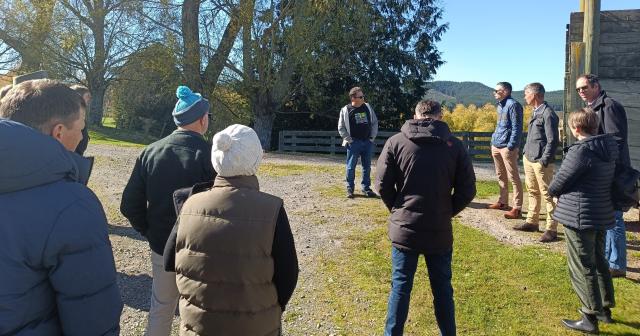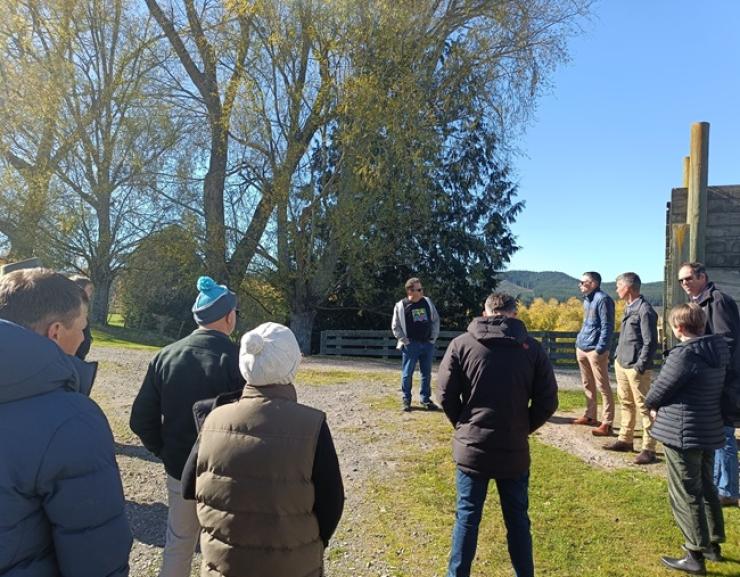Last week B+LNZ’s Farmer Research Advisory Group (FRAG), a group of Farmer Councillors tasked with ensuring B+LNZ research priorities have practical on-farm application, visited Ngapouri Research Farm near Rotorua to witness innovative sheep research and discuss B+LNZ's initiatives to enhance farmer productivity and profitability.

The day marked an opportunity for FRAG members to come together in-person, something they’re keen to do more of. They received updates on research B+LNZ is investing in – such as the Smartworm app, the Eliminating Facial Eczema Impacts programme and parasite management as well as talking about their role with future research opportunities.
Consisting of 16 Farmer Councillors with a particular interest in on-farm research and innovation, FRAG offers input and guidance to the B+LNZ research team, ensuring levy funds are directed towards research directly benefitting farmer profitability and productivity.
Deeply involved in various initiatives such as the Eliminating Facial Eczema Impacts (EFEI) programme and Parasite research, FRAG serves as a sounding board for researchers and B+LNZ to ensure the farmer perspective remains central to decision-making.
FRAG Chair Paul Crick reflected on the morning’s discussions, saying: “Our role as members of FRAG extends beyond the paddock; it's about steering research towards tangible outcomes that enhance farm productivity and profitability.
“We want to ensure that B+LNZ is investing in research that can be practically used on farm and creates a toolkit of options for farmers, to have world leading research and tools to improve their business.”
Following the formalities, the group embarked on a field trip to Ngapouri Research Farm, hosted by Dr Mark Oliver and his team. World leading for its research in fields like foetal and child health, nutrition, and epigenetics, the facility is responsible for several fascinating projects, including the use of sheep in developing technologies to aid those with hearing impairments. The visit gave FRAG members the chance to learn about new areas of research that involved livestock outside of B+LNZ funded research.
Interestingly, the research shows a sizeable number of sheep are hearing impaired and sheep ears are notably similar to the human ear, making them ideal subjects for this research. The goal is a better medical device that improves hearing but also treatments with therapeutic agents that may slow or reverse hearing loss.
Sheep at the facility also contribute to research aimed at alleviating hydrocephalus—a condition that occurs among children in New Zealand. By implanting sensors to monitor intracranial pressure, researchers aim to provide families with a means to manage the condition more effectively at home, potentially reducing unnecessary hospital visits.
“Dr Oliver and his team can bring a really interesting perspective to their research since they are working across both animal and human health. It opens up some new ideas and avenues for solutions for our farmers” says Dan Brier, GM Farming Excellence.
The day concluded with an informative presentation by Karin Shütz from AgResearch, focusing on work AgResearch have done on identifying signs of heat stress in sheep. The team also got the opportunity for an update on the Smartworm app, currently undergoing early-stage testing by B+LNZ to determine if it can be used in a New Zealand farm setting to reduce the amount of drench provided to lambs for parasite control, provided by Dr Cara Brosnahan from B+LNZ.
The day was full of valuable insights around how sheep research not only improves farming practices but also medical sciences—a testament to the impact of collaborative efforts between academia, industry, and farming communities.

